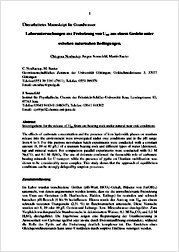| dc.contributor.author | Noubactep, Chicgoua | |
| dc.contributor.author | Sonnefeld, Jürgen | |
| dc.contributor.author | Sauter, Martin | |
| dc.date.accessioned | 2010-11-24T15:58:34Z | |
| dc.date.available | 2010-11-24T15:58:34Z | |
| dc.date.issued | 2005 | |
| dc.identifier.citation | Grundwasser; Vol. 10.2005, No. 1, p. 35-42 | |
| dc.identifier.uri | http://hdl.handle.net/11858/00-1735-0000-0001-33E0-5 | |
| dc.description.abstract | The effects of carbonate concentration and the presence of iron hydroxide phases on uranium release into the environment were investigated under oxic conditions and in the pH range from 6 to 9. For this purpose not-shaken batch experiments were conducted with a constant amount (8, 10 or 40 g/l) of a uranium bearing rock and different types of water (deionised, tap and mineral water). For comparison parallel experiments were conducted with 0.1 M Na 2 CO 3 and 0.1 M H 2 SO 4 . The use of dolomite confirmed the favourable role of carbonate bearing minerals for U transport while the presence of pyrite on Uranium mobilisation was shown to be considerably more complex. This study shows that the approach of equilibrium conditions can be strongly delayed by sorption processes. | |
| dc.format.extent | 29 S. | |
| dc.format.mimetype | application/pdf | |
| dc.language.iso | deu | |
| dc.relation.ispartofseries | Grundwasser | |
| dc.rights.uri | http://e-docs.geo-leo.de/rights | |
| dc.subject.ddc | 551.9 | |
| dc.subject.gok | VJF 000 | |
| dc.title | Laboruntersuchungen zur Freisetzung von Unat aus einem Gestein unter oxischen naturnahen Bedingungen | |
| dc.type | article | |
| dc.subject.gokverbal | Umweltgeochemie insgesamt | |
| dc.bibliographicCitation.volume | 10 | |
| dc.bibliographicCitation.issue | 1 | |
| dc.bibliographicCitation.firstPage | 35 | |
| dc.bibliographicCitation.lastPage | 42 | |
| dc.identifier.doi | 10.23689/fidgeo-819 | |
| dc.identifier.ppn | 573613079 | |
| dc.type.version | publishedVersion | |
| dc.bibliographicCitation.journal | Grundwasser | |
| dc.relation.collection | Geologische Wissenschaften | |
| dc.description.type | research | |


